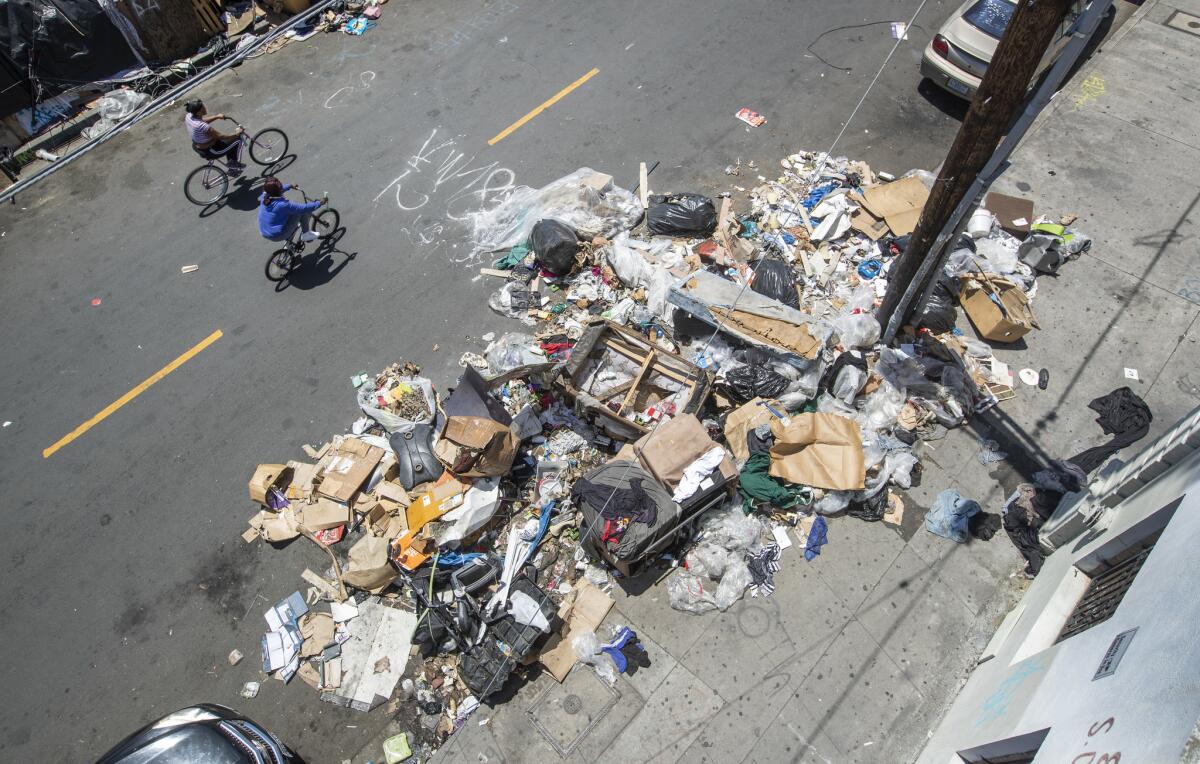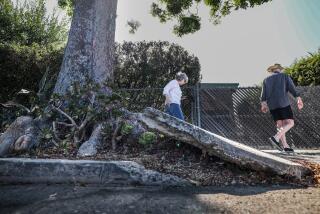Column: There’s a trash and rodent nightmare in downtown L.A., with plenty of blame to go around

The trash trucks arrived early Wednesday afternoon, and members of the cleanup team from the Los Angeles sanitation division came with protective coveralls and white masks.
A mountain of rotting, oozing, stinking trash awaited them, stretching a good 20 yards along a skid row alley. Rats popped their heads out of the debris like they were in a game of Whac-A-Mole, then scampered for cover as a tractor with a scoop lurched toward them.
Two homeless people, who live in tents pitched alongside the trash, watched the proceedings with a look of weary surrender.
RELATED: Los Angeles is facing an apocalypse as we lollygag in our flip-flops »
I’m sorry if I’ve ruined your appetite as you scrub the grill for a holiday weekend barbecue, but the scene I’ve just described is a routine part of life in the downtown section of the nation’s second-largest city.
The trash problem is not confined to any one street, but this particular location on the 800 block of Ceres Avenue is surrounded by food distribution companies that sell to shoppers, vendors, stores and restaurants. I counted seven within a block, so you have to wonder — given the colonies of football-size rats — about the potential contamination of the food supply chain and the spread of disease.
“When the typhus outbreak was first reported in October, that was one place we knew rats were, for sure.”
— Estela Lopez, head of the Downtown Industrial Business Improvement District
“I have had many conversations with the city about that,” said Estela Lopez, who runs the Downtown Industrial Business Improvement District, or BID. “When the typhus outbreak was first reported in October, that was one place we knew rats were, for sure.”
Lopez has spent many years on the skid row beat, and she’s understandably frustrated by the City Hall response. A lot of city officials and employees work hard and do a great job, she said. But they’re not keeping up with the demand, and calls to the 311 service line can take days, weeks and months to get a response.
Elena Stern, spokeswoman for the city Department of Public Works, said the backlog on service calls for trash pickup around homeless encampments sits at just under 8,400 currently. On average, the city gets six calls per site.
“If it’s a homeless encampment, it’s a lengthier process because humans are involved and we have to meet certain protocols,” she said, including a survey of who’s there, an inventory of personal property and notice of a cleanup.
To Lopez, it’s a situation that screams for a more urgent response.
“Skid row is the worst it’s been from a sanitation perspective and a safety perspective and a humanitarian perspective,” Lopez said. “It’s easy for me in the cheap seats to say what should or shouldn’t be done, but as a native Angeleno I feel that our city looks and feels mismanaged. When you take the oath to become mayor or a City Council member, your job is to run this city. It’s to manage this city.”
When KNBC-TV Channel 4’s Joel Grover and Amy Corral reported on the Ceres Avenue dump last October, Mayor Eric Garcetti jumped in and the city cleaned it up right away. The same news crew just went back and reported that the heap was as big as before, and it got cleaned up again.
“Skid row is the worst it’s been from a sanitation perspective and a safety perspective and a humanitarian perspective.”
— Estela Lopez
Stern said that since October, Ceres Avenue litter has been cleared nine times. The BID staff disputes that, but whatever the correct number of cleanups, the dumpers are winning.
So who’s tossing all that trash, turning city streets into landfills?
Without doubt, some homeless people discard junk on the streets where they live, and not always in the trash bins that dot the district by the dozens. But they don’t appear to be the biggest polluters. Not even close, and I’ll get back to that in a minute.
I spent a few hours one morning on trash patrol with Jesse Ramirez, operations manager for Lopez’s maintenance and safety crew. He told me the 17-person team picks up four tons of trash each day, but the recent numbers have been even higher. One two-person crew walks up and down San Pedro all day between 4th and 7th streets.
At 9 a.m. Thursday, we had been out for not quite two hours, and already several pickup trucks had been filled with trash. There had also been six service calls to the BID from merchants — four to pick up human waste and two to clear storefronts blocked by encampments.
Joey Joseph, who owns a seafood distribution center on Gladys Avenue near 4th, called to report urine and feces on the sidewalk where vendors pull in to load their vehicles. Joseph told me he also calls police and City Hall, along with the BID, so I asked how often.
“It’s every day,” Joseph said as two of Ramirez’s crew picked up the waste, disinfected the area and then power-washed. “Usually several times a day.”
On Agatha Street near Crocker Street, I watched a homeless dumpster diver half-disappear into a bin, digging for recyclables. As I was watching, and standing with Ramirez and one of his uniformed deputies, a man exited an alley on foot carrying several boxes and other debris and threw the junk down on the sidewalk, right in front of us.
“You can’t do that,” Ramirez protested, ordering the man to pick up the trash and properly dispose of it in a bin.
We followed him back into the alley, where he tossed the junk into a dumpster and then showed Ramirez the tarp he sleeps under. He said the business owners allow him to sleep there in return for dumping all the trash, and they apparently don’t care where he disposes of it.
This didn’t come as a surprise. Ramirez said the BID has confronted business owners about illegal dumping, but if you don’t catch them in the act, and supply photographic evidence to authorities, nothing happens.
A merchant near Ceres told me that once a pile takes shape, the appearance of lawlessness and neglect is a magnet for other dumpers. Trucks pull in and toss construction or landscaping debris onto the pile, and homeless people do their part, too.
Councilman Jose Huizar represents the downtown area, and two of his staffers told me they have requested more resources to knock down illegal dumping. There’s definitely a backlog of service calls, they said, and some areas downtown don’t get the attention they need because they’re not in a BID. The 800 block of Ceres, in fact, is just south of Lopez’s BID, and dumpers may be taking advantage of the fact that there are no regular patrols.
When I was at the Ceres Avenue trash pile, I noticed a lot of packing materials, food crates and bins that appeared to be from local businesses. Word on the street, from merchants and homeless people, was that some of the more unscrupulous merchants routinely dump their own trash on the streets or pay homeless people a few bucks to get rid of it for them.
The dumping got worse, one merchant claimed, when the city switched to a new recycling system that gave monopolies to companies in each sector of the city.
“I was paying $80 a month, and my cost went up to $300,” said the merchant, who said that rather than get gouged, some business owners began illegally dumping.
He also showed me photos he has taken of homeless people pushing trash from nearby produce outlets to the Ceres Avenue alley in shopping carts, and asked me not to use his name because he’s been retaliated against for complaining. He then showed me photos of rotten trash dumped in front of his shop, presumably from the people he confronted.
Stern said the recycling fees might be one small factor, but some merchants never participated in the recycling program and have a history of dumping. Stern said 25 illegal dumping citations have been written in the area this year, and the department is bringing in additional patrols, with more video surveillance. The department is also considering monetary rewards for people who report illegal dumping.
Stern said a minor offense gets a $75 fine, but a worse offense can bring a $1,000 fine and six months in jail.
I’d say it’s time for City Hall to step up the prosecution and the penalties, and maybe suspend business licenses for repeat offenders. That ought to get the attention of the slobs who keep fouling their own nest.
The morning after Ceres was cleaned up, I went back and saw several crushed tomatillos on the ground. Stern said a much bigger dump had been cleaned up earlier that morning, and the sanitation team was following leads back to a suspected merchant.
Ramirez and I then cruised a street just a few blocks west of there — the 800 block of Crocker.
There, we found a wretched mound of trash extending from the sidewalk into the middle of the street. A homeless woman, pushing a broom outside a nearby business, told me the pile had been there about two weeks.
Drivers swerved and pedestrians tiptoed through the trash, all too familiar with such hazards. Just another day in the city.
More to Read
Sign up for Essential California
The most important California stories and recommendations in your inbox every morning.
You may occasionally receive promotional content from the Los Angeles Times.











